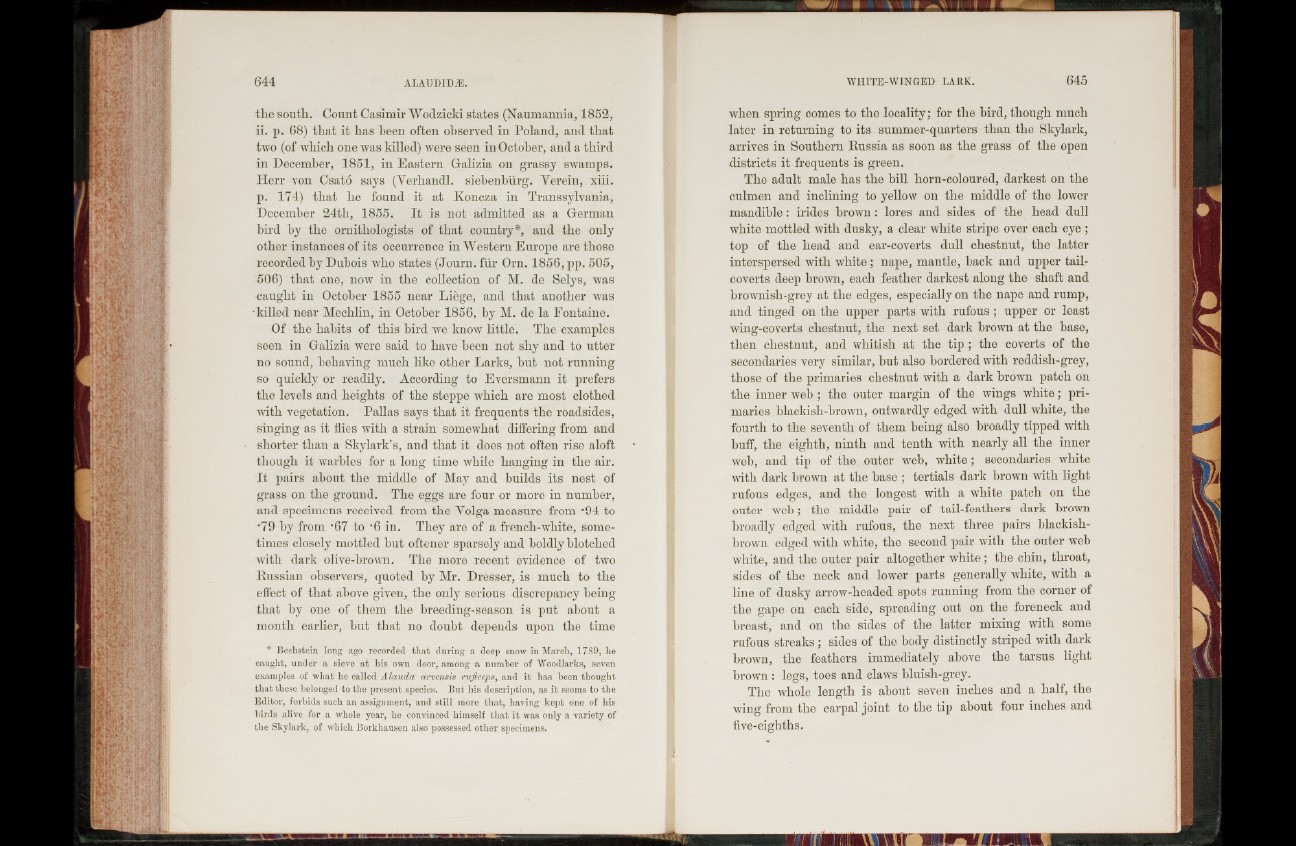
tlie south. Count Casimir Wodzicki states (Naumannia, 1852,
ii. p. 68) that it has heen often observed in Poland, and that
two (of which one was killed) were seen in October, and a third
in December, 1851, in Eastern Galizia on grassy swamps.
Herr von Csató says (Yerhandl. siebenbürg. Yerein, xiii.
p. 174) that he found it at Koncza in Transsylvania,
December 24th, 1855. I t is not admitted as a German
bird by the ornithologists of that country*, and the oidy
other instances of its occurrence in Western Europe are those
recorded by Dubois who states (Journ. ftir Orn. 1856, pp. 505,
506) that one, now in the collection of M. de Selys, was
caught in October 1855 near Liège, and that another was
•killed near Mechlin, in October 1856, by M. de la Fontaine.
Of the habits of this bird we know little. The examples
seen in Galizia were said to have been not shy and to utter
no sound, behaving much like other Larks, but not running
so quickly or readily. According to Eversmann it prefers
the levels and heights of the steppe which are most clothed
with vegetation. Pallas says that it frequents the roadsides,
singing as it flies with a strain somewhat differing from and
shorter than a Skylark’s, and that it does not often rise aloft
though it warbles for a long time while hanging in the air.
I t pairs about the middle of May and builds its nest of
grass on the ground. The eggs are four or more in number,
and specimens received from the Yolga measure from '94 to
•79 by from -67 to -6 in. They are of a french-white, sometimes
closely mottled but oftener sparsely and boldly blotched
with dark olive-brown. The more recent evidence of two
Russian observers, quoted by Mr. Dresser, is much to the
effect of that above given, the only serious discrepancy being
that by one of them the breeding-season is put about a
month earlier, but that no doubt depends upon the time
* Bechstein long ago recorded that during a deep snow in March, 1789, he
caught, under a sieve at his own door, among a number of Woodlarks, seven
examples of what he called Alauda arvensis ruficeps, and it has been thought
that these belonged to the present species. But his description, as it seems to the
Editor, forbids such an assignment, and still more that, having kept one of his
birds alive for a whole year, he convinced himself that it was only a variety of
the Skylark, of which Borkhausen also possessed other specimens.
when spring comes to the locality; for the bird, though much
later in returning to its summer-quarters than the Skylark,
arrives in Southern Russia as soon as the grass of the open
districts it frequents is green.
The adult male has the bill horn-coloured, darkest on the
culmen and inclining to yellow on the middle of the lower
mandible: irides brown: lores and sides of the head dull
white mottled with dusky, a clear white stripe over each eye ;
top of the head and ear-coverts dull chestnut, the latter
interspersed with white; nape, mantle, back and upper tail-
coverts deep brown, each feather darkest along the shaft and
brownish-grey at the edges, especially on the nape and rump,
and tinged on the upper parts with rufous; upper or least
wing-coverts chestnut, the next set dark brown at the base,
then chestnut, and whitish at the t ip ; the coverts of the
secondaries very similar, but also bordered with reddish-grey,
those of the primaries chestnut with a dark brown patch on
the inner web ; the outer margin of the wings white; primaries
blackish-brown, outwardly edged with dull white, the
fourth to the seventh of them being also broadly tipped with
buff, the eighth, ninth and tenth with nearly all the inner
web, and tip of the outer web, white; secondaries white
with dark brown at the base ; tertials dark brown with light
rufous edges, and the longest with a white patch on the
outer web; the middle pair of tail-feathers dark brown
broadly edged with rufous, the next three pairs blackish-
brown edged with white, the second pair with the outer web
white, and the outer pair altogether white; the chin, throat,
sides of the neck and lower parts generally white, with a
line of dusky arrow-headed spots running from the corner of
the gape on each side, spreading out 011 the foreneck and
breast, and on the sides of the latter mixing with some
rufous streaks; sides of the body distinctly striped with dark
brown, the feathers immediately above the tarsus light
brown : legs, toes and claws bluisli-grey.
The whole length is about seven inches and a half, the
wing from the carpal joint to the tip about four inches and
five-eighths.